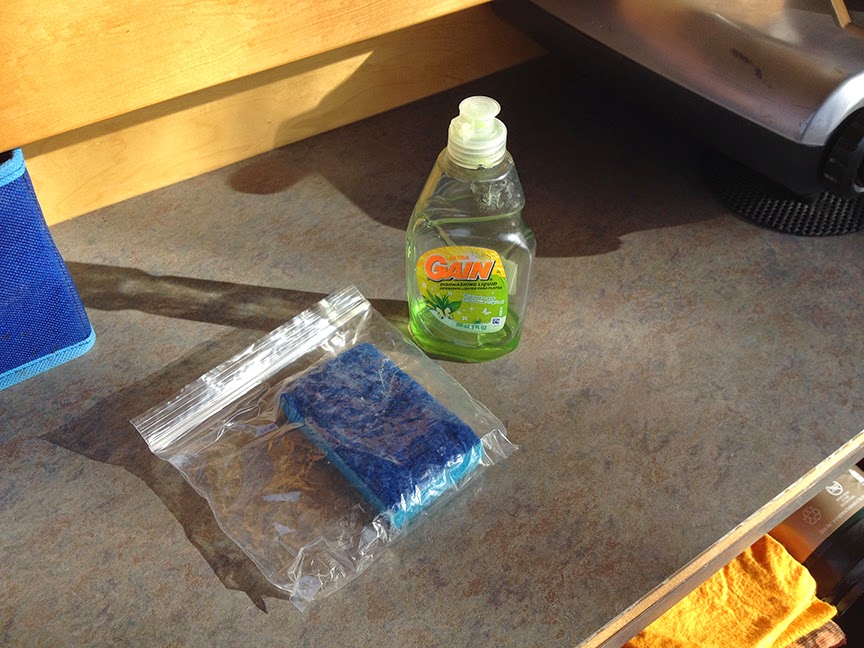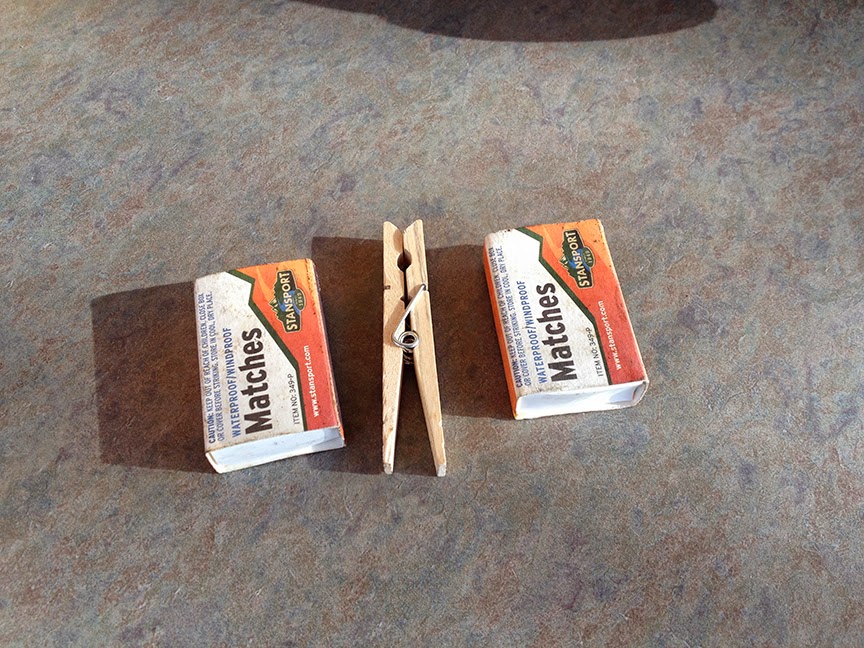Friday Teardrop Photo
This photo from California State Parks is not a teardrop trailer, but these folks really know how to camp in style. The photo was shot in the Big Basin Redwoods State Park, the oldest state park in California.
Nevada Teardrop Camping: Desatoya Range
We live in Northern Nevada, but tend to take the teardrop out to neighboring states: California, Oregon, Utah and Arizona. This year, we've decided to go exploring in our own state and find places we've never been to—or even expected. Nevada is a huge state, so many of these places could take up to a day to get to, but the Sunflower is up to the challenge.
From a tip, we took a few days and headed off into the Nevada desert on the Loneliest Road in America. Highway 50 runs across the central part of the state and was given its desolate name by Life magazine in 1986. It deters a lot of people from driving on it, but many people love the wide open spaces and lack of traffic.
Near the miniature town of Middlegate, we turned onto Highway 722 and down a dirt hunting and cattle track that took us to the beautiful Desatoya Mountain Range and some rustic, but free Bureau of Land Management campsites. On this February weekend, no one was there, and we still saw no other people for the next few days. The place had tons of trees (unusual for this area), a stunning gorge, a creek, wild horses and cactus. We fell in love with the area right away.
We've marked a few more places on our map and will be teardrop camping across our state this year. I would love to hear about how you teardrop camp in your own state, and what new places you've found while exploring your own backyard.
From a tip, we took a few days and headed off into the Nevada desert on the Loneliest Road in America. Highway 50 runs across the central part of the state and was given its desolate name by Life magazine in 1986. It deters a lot of people from driving on it, but many people love the wide open spaces and lack of traffic.
Near the miniature town of Middlegate, we turned onto Highway 722 and down a dirt hunting and cattle track that took us to the beautiful Desatoya Mountain Range and some rustic, but free Bureau of Land Management campsites. On this February weekend, no one was there, and we still saw no other people for the next few days. The place had tons of trees (unusual for this area), a stunning gorge, a creek, wild horses and cactus. We fell in love with the area right away.
We've marked a few more places on our map and will be teardrop camping across our state this year. I would love to hear about how you teardrop camp in your own state, and what new places you've found while exploring your own backyard.
Friday Teardrop Photo
The weather has been so warm, we were able to take a February camping trip into central Nevada. We stopped at the Sand Mountain Recreation Area off of Highway 50 and took a few photos. This place is usually packed with toy haulers and other large RVs—bringing various dirt bikes and quads to ride the massive sand dunes.
What do we keep in the teardrop galley?
The galley of a teardrop is what sets this type of trailer apart from every other trailer. The galley is usually small, but can be extremely efficient and well designed. While the Sunflower is a commercial trailer, I really like the galley. It's open and clean and I can see nearly everything. We don't keep very much in it as you can see below.
Our stove is a Coleman grill with one burner. We've cooked everything from steak and fish to pancakes and eggs. The little legs keep it wedged under the galley shelf during transportation. I do put little rubber skids under the legs to keep it from sliding.
This little sunflower is a wooden trivet that we use to put hot pans or pots on. Hot cast iron will burn or melt wood and plastic picnic tables.
Our cutting boards fit perfectly into the galley shelf. I've mentioned this before, but the smaller one is actually a divider that goes into a spiral binder.
Our various cups, plates and crockery are all plastic for travel reasons. Most of them I got from a thrift store, and we have enough to feed four to five people. The fish plates are used as serving plates, and they don't fit the Sunflower theme very well (I won them during a contest at a picnic).
In two blue toy boxes we carry olive oil, spray oil, salt, pepper, spices and some hot sauces.
Hot coffee on a cold morning while camping is very important to us. This French press by Thermos makes at least four small cups of coffee.
Two essential items on the shelf are paper towels and aluminum foil....
...and two spatulas—one plastic and one metal.
In our two red dishpans, we carry everyday kitchen items like...
This little sunflower is a wooden trivet that we use to put hot pans or pots on. Hot cast iron will burn or melt wood and plastic picnic tables.
Our cutting boards fit perfectly into the galley shelf. I've mentioned this before, but the smaller one is actually a divider that goes into a spiral binder.
Our various cups, plates and crockery are all plastic for travel reasons. Most of them I got from a thrift store, and we have enough to feed four to five people. The fish plates are used as serving plates, and they don't fit the Sunflower theme very well (I won them during a contest at a picnic).
We also carry a small spray bottle filled with soap and water to do quick dish washes while eating on the road.
Hot coffee on a cold morning while camping is very important to us. This French press by Thermos makes at least four small cups of coffee.
Two essential items on the shelf are paper towels and aluminum foil....
...and two spatulas—one plastic and one metal.
In our two red dishpans, we carry everyday kitchen items like...
...our cast iron pan which I rescued from a rust-covered life in someone's yard,
a small bag that holds plastic grocery bags for garbage,
our two oven mitts,
an extra bottle of propane,
and some dish towels and rags for cleaning up.
The only (and very small) drawer holds not only our cutlery, but a few tools and odds and ends like...
...the dish soap and sponge,
various kitchen tools like a good knife, peeler, can opener, bottle opener and tongs.
Of course, we have enough spoons, forks and knives for several people including two grapefruit spoons.
We've also crammed in some lighters with fuel, scissors, a mesh strainer and a pen.
We also have some emergency matches, and a clothespin always seems to come in handy.
In our one cabinet (along with the battery) we have our various pots. Personally, I think we have too many, but they all serve different needs. This one is usually reserved for our shower setup.
This pot has a locking lid and holes for draining pasta and vegetables. We carry a measuring cup inside of it.
This pot has two lips for pouring out water or hot milk into coffee and hot chocolate.
This is a bowl we use for mixing breads and eggs or for holding a salad. It was left behind in a campground bear box.
This pot is primarily used for heating up water on the campfire. It's become a little black.
Last of all is our open storage area. This area holds the two dishpans, the main propane tank, a 2.5 gallon water container and a plastic bin for dry goods. The plastic bin is handy in that it can be taken out of the galley and moved to a picnic table for quick access.
The plastic bin (which we've had for nearly 13 years) usually carries coffee, hot chocolate, a container of sugar, honey, plastic bags, creamer, rice or pasta and some storage containers. On a short or long trip—this thing is stocked full.
Looking back at the photos—it seems like a lot of stuff! However, when they are neatly organized and stored away, all the items don't seem like too much to carry around in your own mobile kitchen.
Friday Teardrop Photo
I ran into this photo years ago when I first started researching teardrop trailers. If this doesn't want to make you get one...I don't know what will.
100 Routes Across America
100 Routes Across America is a personal blog written and edited by freelance writer and blogger Shannon Entin. Her desire to experience more out of life while dealing with weight issues and a heart condition was the catalyst for starting this blog that features both routes and small town destinations across America. The blog is named after the U.S. Highways numbers 1 to 100.
The blog covers routes in the Eastern, Central and Western sections of the country as well as travel for enrichment and wellness, travel tips, reviews and itineraries. Most of the blog focuses on family travel, but also touches on the out of the way places that are worth visiting during a road trip. For some reason, I'm dying to take the teardrop to Wall Drug in South Dakota.
The blog covers routes in the Eastern, Central and Western sections of the country as well as travel for enrichment and wellness, travel tips, reviews and itineraries. Most of the blog focuses on family travel, but also touches on the out of the way places that are worth visiting during a road trip. For some reason, I'm dying to take the teardrop to Wall Drug in South Dakota.
Photos by Shannon Entin
Friday Teardrop Photo
From one of my new favorite sites comes this photo of a homemade teardrop trailer...for a dog. Maggie's owner wanted to keep his dog safe while traveling around the country with her and his motorcycle. Maggie has her own 2.5x4 foot trailer that weighs 225 lbs. The little trailer, cut with a CNC router, has rigid foam insulation, interior padding, a front porthole and even a little step for Maggie to jump into her trailer.
Photo and story by Do It Yourself RV
Do It Yourself RV
If you want to build your own teardrop trailer, check out the website, Do It Yourself RV for some inspiration, step-by-step instructions and examples of how many different handmade teardrops are on the road. Check out Larry's teardrop, made from recycled materials. His guide comes with explanations for each step. For other trailer ideas, do a search for "teardrop trailer" on the site.
Not only does the website have home built teardrop trailers, but it includes small trailer and campers and some great ideas on how to make your own vehicle more camp ready. For example, Joe and Eric of Minnesota wanted to take a break from work and travel the U.S. They outfitted the back of their SUV with a wooden storage area that looks very much like a teardrop galley.
The site also has news and information on how to RV full time, how to back up and tow a trailer, RV gear, fun vintage photos, and modifications to commercial trailers and campers.
Photos courtesy of Do It Yourself RV
Subscribe to:
Posts (Atom)
























































